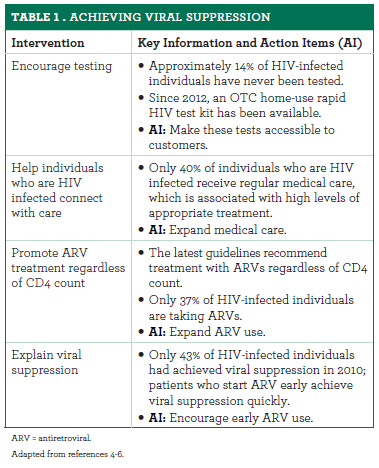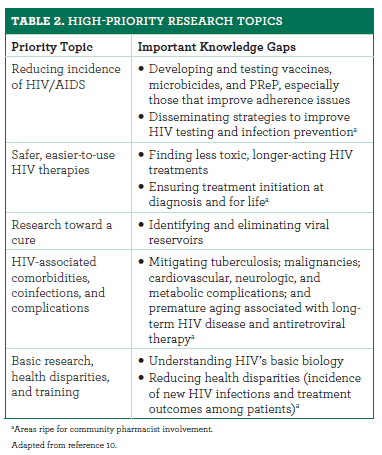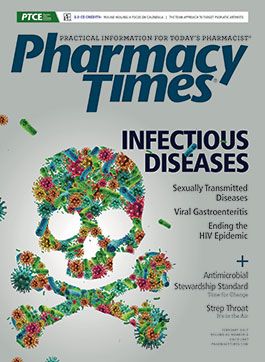Publication
Article
Pharmacy Times
HIV: Ending the Epidemic
Author(s):
Immersion in HIV/AIDS practice is the best way to understand this infectious disease and keep current with treatment changes.
Immersion in HIV/AIDS practice is the best way to understand this infectious disease and keep current with treatment changes. Most community pharmacists are generalists, but they almost certainly provide care for some—or even many—HIV-infected individuals. This article provides an overview of the current status of medicine and research regarding HIV. It can also serve as a reminder that pharmacists are part of the fight to beat HIV.
90-90-90 by 2020
The Joint United Nations Programme on HIV/AIDS (UNAIDS) proposed the global 90-90-90 by 2020 program in 2015. Its premise is clear, and if successful, it could remove the “epidemic” label from this infection, reducing new infections by 70%. The goal is that by 2020 (just 3 years from now)1,2:
- 90% of all HIV-infected persons will know their status
- 90% will receive treatment
- 90% will have an undetectable HIV RNA level
Until very recently, treatment cost was a barrier in most nations. Global activism has created the means to treat everyone, regardless of income or social isolation; the average cost of antivirals has fallen from an average of $15,000/year to $80/year in developing countries.1,2 HIV clinicians are focusing on fragile populations in many countries: gay men, sex workers, drug users, and prisoners, as early treatment can reduce infection rates by 90%.1,2
In September 2016, Sweden became the first country to meet the 90-90-90 Fast Track targets.3 The United States has set goals that align with the 90-90-90 goals set by UNAIDS. American statistics are improving, but health care professionals must work to eliminate geographic and socioeconomic disparities.4 Table 1 lists the necessary steps toward that elimination.

Rapid Is the Right Word
Perhaps the most important point in Table 1 is that early initiation of antiretroviral (ARV) therapy is critical to helping patients quickly achieve viral suppression. All HIV guidelines recommend initiating ARV therapy in all patients, regardless of CD4 count. HIV clinics around the country are examining rapid protocols that start infected patients on ARV therapy at diagnosis—that is, on the same day. This means providers should evaluate, assess, and observe first-dose ARV therapy at the initial appointment. This increases workload at this first appointment, but also reduces (1) the time to virologic suppression and (2) the likelihood of HIV transmission. The health care team must coordinate closely to address the patient’s multiple needs, including psychological and social stabilization after diagnosis and payment (health insurance).7
Several factors, however, can delay ART initiation, including patient acceptance and socioeconomic barriers like health insurance, housing, and substance abuse. In the United States, ARV-related costs remain high and complex. Factors that influence cost include the patient’s specific medical and insurance coverage, accessibility, and regional variation.8
Cost is so important that AIDS.info, the country’s leading source of information, dedicates a web page to the concern (aidsinfo.nih.gov/guidelines/html/1/adult-and-adolescent-arv-guidelines/459/cost-considerations-and-antiretroviral-therapy). It reminds us that although generics reduce costs, they can also increase pill burden (and potentially decrease adherence). In some cases, switching to generics can result in higher co-pays for patients. Pharmacists can be indispensable when clinicians are considering generics.8
Keep the Ball Rolling
With significant advances brightening the future for HIV treatment, pharmacists remain central to continuing progress in this medication-essential fight. Although many regimens have lower pill burdens than previously, HIV-infected patients need considerable support and encouragement, especially around adherence. Staying abreast of new adherence reminders and recommending them to patients is an easy, effective way to ensure the near-total adherence needed for viral suppression.
No study has identified the best adherence devices for HIV-infected patients; individual preferences and lifestyle factors vary tremendously. Patients can use pillboxes, timers, time-caps, alarms, and other reminders designed to enhance adherence. Some of these are now discreet or vibrating, which protects confidentiality. Often, patients’ best reminder is simpler than that—the constant companion, the cell phone and its alarm, or a note on the bathroom mirror.
Think About Research
HIV treatment is largely—and ideally—community based. Table 2 lists current high-priority research areas in HIV, emphasizing areas ripe for community pharmacist involvement. The American College of Clinical Pharmacy’s (ACCP) Research Affairs Committee notes that the country needs new research partnerships, and these partnerships must engage organized patient communities, community-based health care providers, and academic researchers.9 ACCP also provides guidance to develop research competencies (accp.com/stunet/compass/researchOpportunities.aspx). Community pharmacists who would like to engage in research can start by contacting their nearest school of pharmacy, or asking local HIV clinics if they can help with their research.

End Note
Aggressive intervention in HIV care can end this epidemic while research pursues a cure. Pharmacists who talk to their HIV-infected patients regularly can help ensure they stay medication-adherent and achieve viral suppression early.
Ms. Wick is a Visiting Professor at the University of Connecticut School of Pharmacy.
References
- European Commission. 90-90-90: An ambitious treatment target to help end the AIDS epidemic. eudevdays.eu/topics/90-90-90-ambitious-treatment-target-help-end-aids-epidemic. Published June 3, 2015. Accessed January 3, 2017.
- MacArthur RD. 90-90-90 by 2020. Patient Care website. patientcareonline.com/hiv-aids/90-90-90-2020. Published November 16, 2015. Accessed January 3, 2017.
- Avert News. Sweden reaches 90-90-90 fast track targets. Avert website. avert.org/news/sweden-reaches-90-90-90-fast-track-targets. Published September 14, 2016. Accessed January 3, 2017.
- The White House. National HIV/AIDS strategy for the United States: Updated to 2020. whitehouse.gov/sites/default/files/docs/nhas_2020_indicator_supplement_8-15.pdf. Published August 2015. Accessed January 3, 2017.
- CDC. Viral suppression is the goal of HIV medical care. stacks.cdc.gov/view/cdc/26176. Published November 25, 2014. Accessed January 3, 2017.
- FDA. First rapid home-use HIV kit approved for self-testing. FDA website. www.fda.gov/ForConsumers/ConsumerUpdates/ucm310545.htm. Accessed January 3, 2017.
- Pilcher C, Ospina-Norvell C, Dasgupta A, et al. The effect of same-day observed initiation of antiretroviral therapy on HIV viral load and treatment outcomes in a US public health setting. J Acquir Immune Defic Syndr. 2017;74(1):44-51.
- U.S. Department of Health and Human Services. Guidelines for the use of antiretroviral agents in HIV-1-infected adults and adolescents: Limitations to treatment safety and efficacy. AIDS info website. aidsinfo.nih.gov/guidelines/html/1/adult-and-adolescent-arv-guidelines/459/cost-considerations-and-antiretroviral-therapy. Updated July 14, 2016. Accessed January 3, 2017.
- Dowling TC, Murphy JE, Kalus JS, et al; American College of Clinical Pharmacy. Recommended education for pharmacists as competitive clinical scientists. Pharmacotherapy. 2009;29(2):236-244. doi: 10.1592/phco.29.2.236.
- National Institute of Health Office of AIDS Research. NIH HIV/AIDS research priorities and guidelines for determining AIDS funding. grants.nih.gov/grants/guide/notice-files/NOT-OD-15-137.html. Released August 12, 2015. Accessed January 4, 2017.







